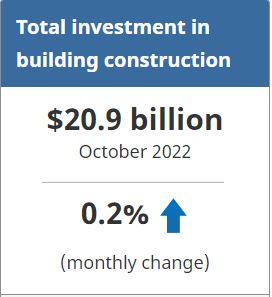Statistics Canada: Investment in Building Construction, October 2022
Nationally, investment in building construction in October was largely steady, up 0.2% to $20.9 billion, with Ontario accounting for nearly all the gains. The residential sector edged down 0.1% to $15.4 billion, while the non-residential sector increased 0.9% to $5.5 billion.

On a constant dollar basis (2012=100), investment in building construction increased 0.3% to $12.3 billion.
Single family and multi-unit investment head in opposite directions
Investment in residential building construction was down slightly by 0.1% to $15.4 billion in October. Quebec caused most of this fall, as they continued to decline in this component after peaking in May.
Single family home investment decreased 2.3% to $8.2 billion in October, with nine provinces reporting declines. This was the largest monthly decrease for single family construction since July 2021. On a constant dollar basis, this was the eighth consecutive monthly drop after its historic peak in February 2022.
Multi-unit construction investment increased 2.5% to $7.2 billion, with Ontario (+8.6%) accounting for most of the growth. This was the province’s largest recorded monthly increase since June 2020.
Non-residential investment continues to climb
Investment in non-residential construction was up 0.9% to $5.5 billion in October, with Ontario (+1.2%) leading the gains in each component.
Industrial construction investment rose 1.3% to $1.1 billion for the month and was up 24.4% year over year. This was the 11th consecutive monthly increase in this component.
Commercial construction investment increased 1.3% to $3.1 billion in October. Overall, seven provinces reported gains and three reported declines. Kelowna and Vancouver each had a new retail project that contributed to the gains in British Columbia.
Institutional construction investment edged down 0.3% to $1.4 billion. Manitoba (-21.0%) caused most of the decline, reversing the significant gains the province saw in the last two months.
For more information on housing, please visit the Housing statistics portal.
Note to readers
Data are subject to revisions based on late responses, methodological changes and classification updates. Unadjusted data have been revised for the previous two months. Seasonally adjusted data have been revised for the previous three months.
Data presented in this release are seasonally adjusted with current dollar values unless otherwise stated. Using seasonally adjusted data allows month-to-month and quarter-to-quarter comparisons by removing the effects of seasonal variations. For information on seasonal adjustment, see Seasonally adjusted data – Frequently asked questions.
Monthly estimates in constant dollars are calculated using quarterly deflators from the Building Construction Price Index (table 18-10-0135-01). Typically, the first two months of a quarter use the previous quarter’s price level, and the data are revised when the new quarterly price index becomes available.
Detailed data on investment activity by type of building and type of work are now available in the unadjusted current dollar series.
The Trade and Services subcomponent includes buildings such as retail and wholesale outlets, retail complexes and motor vehicle show rooms. More detailed information can be found on the Integrated Metadatabase at Types of Building Structure – 2.2.1 – Trade and services.
Next release
Data on investment in building construction for November will be released on January 16.
Products
Statistics Canada has a “Housing Market Indicators” dashboard. This web application provides access to key housing market indicators for Canada, by province and census metropolitan area. These indicators are automatically updated with new information from monthly releases, giving users access to the latest data.
Source: Statistics Canada

